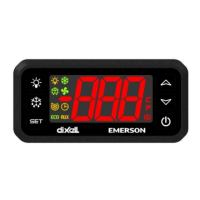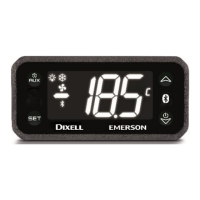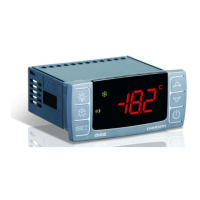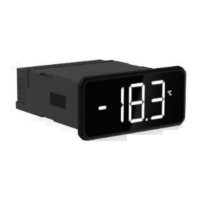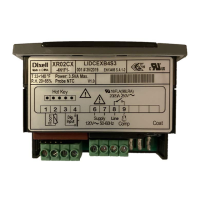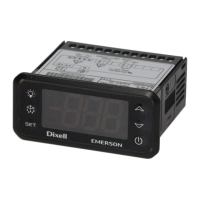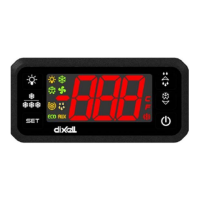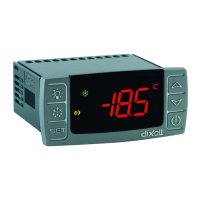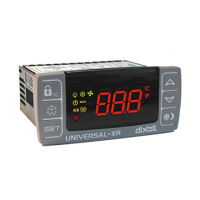1592034020 XR77CHC EN r1.0 2019.01.31 XR77CHC 6/7
power connections. Do not exceed the maximum current allowed on each relay, in case of heavier
loads use a suitable external relay.
17.1 PROBES
The probes shall be mounted with the bulb upwards to prevent damages due to casual liquid
infiltration. It is recommended to place the thermostat probe away from air streams to correctly
measure the average room temperature. Place the defrost termination probe among the evaporator
fins in the coldest place, where most ice is formed, far from heaters or from the warmest place during
defrost, to prevent premature defrost termination.
18 USE THE HOT-KEY
18.1 SAVE PARAMETERS IN A HOT-KEY (UPLOAD FROM INSTRUMENT)
1. Program one controller with the front keypad.
2. When the controller is ON, insert the “HOT-KEY” and push UP button; the “UP” message
appears followed a by flashing “End”
3. Push “SET” key and the “End” will stop flashing.
4. Turn OFF the instrument and then remove the “HOT-KEY”. At the end turn the instrument ON
again.
NOTE: the “Err” message appears in case of a failed programming operation. In this case push again
the UP button if you want to restart the upload again or remove the “HOT-KEY” to abort the operation.
18.2 COPY PARAMETERS FROM A HOT-KEY (DOWNLOAD PARAMETER
VALUES)
1. Turn OFF the instrument.
2. Insert a programmed “HOT-KEY” into the 5-PIN port and then turn the Controller ON.
3. The parameter list of the “HOT-KEY” is automatically copied into the controller memory. During
this operation the “do” message will blink
4. A flashing “End” label will inform that the operation was successful
5. Remove the “HOT-KEY”.
6. After some seconds the instrument will restart, using with the new parameters.
NOTE: the message “Err” is displayed for failed programming. In this case turn the unit off and then on
if you want to restart the download again or remove the “HOT-KEY” to abort the operation.
19 INTERNAL MEMORY
The controller has an internal memory where are stored:
- Two different parameter maps identified as C1 and C2
- Factory default configurations for both C1 and C2 parameters map
The controller is always shipped with:
- Parameter map C1 = factory default configuration C1
- Parameter map C2= factory default configuration C2
Any modification to parameter map C1 or C2 does not change the default factory values.
It is possible to change parameter map between C1 and C2 by using a digital input or a button properly
configurated (ixF or LG2=CC).
It is possible to restore factory defaults values for both C1 or C2 parameters map by using UP2=LdC (Load
default configuration) function.
NOTES:
- If controller is using C1 parameter map, the factory default configuration C1 will be reloaded
overwriting C1 parameter map. The same for parameter map C2.
- The factory default configurations are read only (it is not possible to modify them on the field).
20 ALARM SIGNALLING
Compressor output according to Con e CoF
Linked temperature alarm is not managed
Maximum temperature alarm
Minimum temperature alarm
Maximum temperature for second
temperature alarm
Minimum temperature for second
temperature alarm
Door open more than dxd time
Compressor and fans restarts
20.1 ALARM RECOVERY
Probe alarms “P1”, “P2”, “P3” and “P4” start some seconds after the fault in the related probe; they
automatically stop some seconds after the probe restarts normal operation. Check connections before
replacing the probe. Temperature alarms “HA”, “LA”, “H2” and “L2” automatically stop as soon as the
temperature returns to normal values. It is possible to reset the “EE” alarm by pressing any button.
The alarms “EA”, “CA” and “dA” will automatically stop as soon as the digital input is disabled.
The internal buzzer can be muted by pressing any key if parameter tbA=Y.
21 TECHNICAL DATA
Housing: self-extinguishing ABS
Case: frontal 32x74 mm; depth 60mm
Mounting: panel mounting in a 71x29mm panel cut-out
Body Protection: IP20
Frontal protection: IP65
Terminal blocks: plug-in terminal blocks 2.5 mm
2
wiring
Power supply: (according to the model) 230Vac 10%, 50/60Hz; 110Vac 10%, 50/60Hz
Power absorption: 3.5VA max
Display: 3-digit LED, H=14.2 mm
Inputs: up to 4 NTC, PTC or PT1000 probes
Digital input: up to 2 voltage free contacts
Relay outputs: Compressor SPST 16(5)A, 250VAC
oA2: SPDT 16(5)A, 250VAC
oA3: SPST 5(2)A, 250VAC
oA4: SPDT 7A, 250VAC
Data storing: EEPROM
Kind of action: 1B
Pollution degree: 2
Software class: A
Rated impulsive voltage: 2500V; Overvoltage Category: II
Operating temperature: 0 to 60°C (32 to 140°F)
Storage temperature: -25 to 60°C (-13 to 140°F)
Relative humidity: 20 to 85% (no condensing)
Measuring and regulation range:
NTC -40 to 110°C (-40 to 230°F)
PTC -55 to 150°C (-67 to 302°F)
PT1000 -100 to 200°C (-148 to 392°F)
Resolution: 0.1°C or 1°C (selectable)
Accuracy (ambient temp. 25°C):
NTC or PTC: ±0.1°C ±1 digit
PT1000: ±0.1°C ±1 digit for probes Pb1, Pb2 and Pb3; ±1.0°C ±1 digit for probe Pb4
Real time clock: data maintenance up to 6 months with lithium battery
HOT-KEY inputs: MAX voltage allowed is 3.3VDC. DO NOT CONNECT ANY EXTERNAL POWER
SUPPLY.
21.1 STANDARDS
The complete Declaration of Conformity can be found at:
https://dxapp.cloud/
21.1.1 THE XR77CHC IS COMPLIANT WITH THE FOLLOWING STANDARDS
ETSI EN 300 328 V2.1.1 (2016-11)
ETSI EN 301 489-17 V3.1.1 (2016-11)
IEC EN 60730-2-9: 2008 (Third Edition) and Am.1:2011 in conjunction with IEC 60730-1:2010 (Fourth Edition)
UL 60730-1 Fourth Edition and CAN/CSA-E60730-1:02 Third Edition along with its Amendment 1 dated
February 2007, the Standards for Automatic electrical controls for household and similar use – Part 1: General
requirements.
It therefore meets the essential requirements of the following Directives:
Radio equipment Directive 2014/53/EU
Electromagnetic compatibility 2004/108/EC
Low Voltage equipment 2006/95/EC
21.1.2 THE XR77CHC IS COMPLIANT WITH THE FOLLOWING STANDARDS
FCC 15.247
21.1.3 THE XR77CHC IS COMPLIANT TO PART 15 OF THE FCC RULE
Operation is subject to the following two conditions:
(1) this device may not cause harmful interference, and
(2) this device must accept any interference received, including interference that may cause undesired
operation.”
Unauthorized repairs, changes or modifications could result in permanent damage to the equipment and void
your warranty and your authority to operate this device under Part 15 of the FCC Rules.
NOTE: This equipment has been tested and found to comply with the limits for a Class A digital device,
pursuant to part 15 of the FCC Rules. These limits are designed to provide reasonable protection against
harmful interference when the equipment is operated in a commercial environment. This equipment generates,
uses, and can radiate radio frequency energy and, if not installed and used in accordance with the instruction
manual, may cause harmful interference to radio communications. Operation of this equipment in a residential
area is likely to cause harmful interference in which case the user will be required to correct the interference at
his own expense.
21.1.4 THE XR77CHC IS COMPLIANT TO RSS 102
This device complies with Industry Canada RSS-210. Operation is subject to the following two conditions: (1)
this device may not cause interference, and (2) this device must accept any interference, including
interference that may cause undesired operation of the device.
21.1.5 CET XR77CHC INSTRUMENT REPOND AUX NORMES RSS 102
Le présent appareil est conforme aux CNR d’Industrie Canada applicables aux appareils radio RSS-210.
L’exploitation est autorisée aux deux conditions suivantes : (1) l’appareil ne doit pas produire de brouillage, et
(2) l’utilisateur de l’appareil doit accepter tout brouillage radioélectrique subi, même si le brouillage est
susceptible d’en compromettre le fonctionnement.
22 WIRINGS
22.1 XR77CHC, 16+16+7+5A
Power Supply (terminals 2-3):
110 or 230 Vac @50 or 60Hz
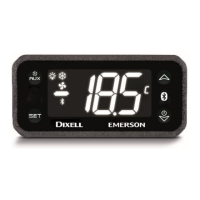
